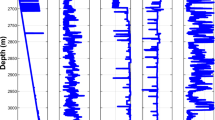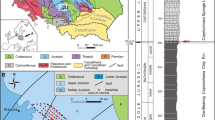Abstract
Horizontal wells dominate the development of unconventional shale reservoirs. Using real time drilling data to steer in a target zone is the key to economic success. Today structural interpretation in unconventional horizontal wells is a manual process that is time-consuming, tedious, and error-prone, especially because gamma-ray (GR) logs are commonly the only available logging-while-drilling data. For the first time, a method named TST3D is developed to automate interpretation of subsurface structure. TST3D (true stratigraphic thickness in three-dimensional space) automates structural interpretation using pattern recognition. Given an initial structural model, TST3D automatically computes true stratigraphic thickness (TST) as the shortest distance from each wellbore survey location to the initial surface, then matches GR patterns in the horizontal well to those seen in a vertical pilot well in TST domain. TST3D inserts fold hinges, bends the structure, then recomputes the modeled GR response, progressively matching the pilot well log signature, from heel to toe in the horizontal well. There are three assumptions in the current version of TST3D: constant layer thickness across the drilled interval, GR variation follows stratigraphic layering, and no faults are present in the drilled section. Those assumptions are reasonable in most shale plays. The TST3D method can be applied in either a post-drill mode for structural interpretation or real-time mode for aiding geosteering. Field tests in different shale plays and complex well trajectories demonstrate that TST3D runs quickly: a structural model of a 10,000-ft horizontal section can be computed in minutes, and a real-time update of 100 ft of new data takes less than a minute. Automating the geosteering correlation process would allow well placement engineers to cover multiple wells simultaneously, increasing the efficiency of the team while potentially improving service quality.
















Similar content being viewed by others
References
Azike O (2011) Multi-well real-time 3D structural modeling and horizontal well placement: an innovative workflow for shale gas reservoirs. In: Presented at the SPE eastern regional meeting, Columbus, Ohio, USA, 17–19 August, SPE-148609-MS, 102118/148609-MS
Bateman R, Hepp V (1981) Application of true vertical depth, true stratigraphic thickness and true vertical thickness log displays. In: Presented at the SPWLA annual logging symposium, Mexico City, Mexico, 23–26 June
Berg CR, Newson AC (2013) Geosteering using true stratigraphic thickness. In: Presented at the unconventional resources technology conference, Denver Colorado, USA, 12–14 August, URTeC-1590259-MS
Ellis D, Singer J (2008) Well logging for earth scientists. Springer, Berlin
Griffiths R (2009) Well placement fundamentals. Schlumberger, Denver
Lesso W, Kashikar S (1996) The principles and procedures of geosteering. In: IADC/SPE 35051
Liang X, Wang L, Zhang J, Xian C, Wang G, Liu X, Zhao C (2015) An integrated approach to ensure horizontal wells 100% in the right positions of the sweet section to achieve optimal stimulation: a shale gas field study in the sichuan basin, China. In: Presented at the international petroleum exhibition and conferences, Abu Dhabi, UAE, 9–12 November, SPE-177474-MS, 102118/177474-MS
Moghaddamjoo A (1989) Constraint optimum well-log signal segmentation. IEEE Trans Geosci Remote Sens 27(5):633–641
Passey Q, Bohacs K, Esch W, Klimentidis R, Sinha S (2010) From oil-prone source rock to gas-producing shale reservoir-geologic and petrophysical characterization of unconventional shale-gas reservoirs. In: SPE 131350
Scholle P, Bebout D, Moore C (1983) Carbonate depositional environments: AAPG Memoir 33. American Association of Petroleum Geologists. ISBN-10: 0891813101
Scholle P, Spearing D (1982) Sandstone depositional environments. AAPG Memoir 31. American Association of Petroleum Geologists. ISBN:9780891813071
Stoner M (2007) Technical geosteering finds the sweet spot. IEEE Trans Geosci Remote Sens 27:71–77
Tearpock D, Bischke R (2003) Applied subsurface geological mapping, 2nd edn. Prentice-Hall Inc., Englewood Cliffs
Xu C, Bayer W, Wunderle M, Bansal A (2016) Normalizing gamma-ray logs acquired from a mixture of vertical and horizontal wells in the haynesville shale. Petrophysics 57(6):638–643
Acknowledgements
We thank Schlumberger for the permission to publish our work. We would like to thank Neil Hurley, Ridvan Akkurt, and Shu Zhang for their technical discussion and contribution in the early stage of the development of TST3D. Thanks to Farid Toghi for providing the illustrative dataset of TST3D work steps.
Author information
Authors and Affiliations
Corresponding author
Additional information
The original paper was presented to the Unconventional Resources Technology Conference, 23–25 July 2018, Houston, Texas, USA.
Abbreviations
Abbreviations
- GR:
-
Gamma ray measurements, GAPI
- LWD:
-
Logging while drilling
- MD:
-
Measured depth (ft)
- TVD:
-
True vertical depth (ft)
- TST:
-
True stratigraphic thickness (ft)
- MLT:
-
Measured log thickness (ft)
- TVT:
-
True vertical thickness (ft)
- TVDT:
-
True vertical depth thickness (ft)
- THL:
-
True horizontal length (ft)
- TD:
-
Total depth (ft)
- \(\phi \) :
-
Wellbore deviation (\(\circ \))
- \(\alpha \) :
-
Angle difference between the bedding azimuth and the wellbore section azimuth (\(\circ \))
- \(\theta \) :
-
Bedding dip (\(\circ \))
- N :
-
Total number of the measurement samples in a TST split panel interval
- ARE:
-
Average relative error for the mismatch between the GR measurements and the models in TST domain
Rights and permissions
About this article
Cite this article
Zhang, T., McCormick, D., Nandlal, A. et al. The TST3D Method for Automated Structural Interpretation in Horizontal Wellbores. Math Geosci 53, 925–944 (2021). https://doi.org/10.1007/s11004-020-09868-z
Received:
Accepted:
Published:
Issue Date:
DOI: https://doi.org/10.1007/s11004-020-09868-z




